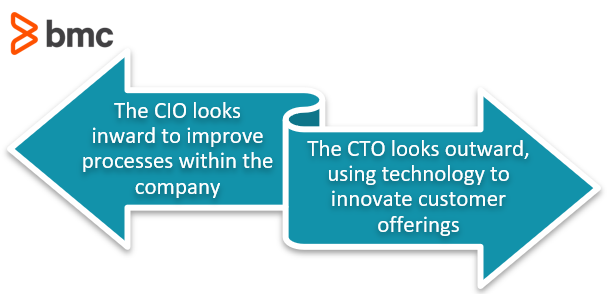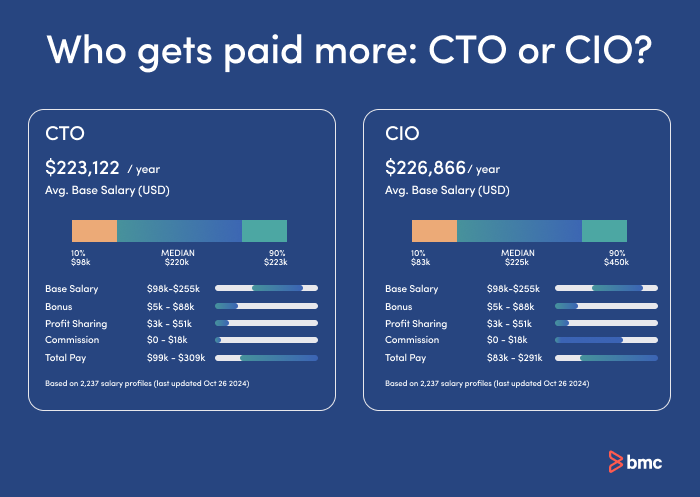As technology has become imperative to businesses large and small, two executive-level roles have become standard:
- Chief information officer (CIO)
- Chief technology officer (CTO)
But the distinction between the two can be confusing, as “information” and “technology” typically go hand-in-hand. So, what is the difference between these two roles? Is a CIO in a higher position in the corporate hierarchy than a CTO? How does one focus on technology while the other focuses on information?
A simple distinction is that the CIO typically looks inward, aiming to improve processes within the company, while the CTO looks outward, using technology to improve or innovate products that serve the customers.
Let’s take a look at the difference between CIO and CTO roles, as well as whether your company should employ one or both.

What does CIO stand for?
What is a CIO? CIO stands for Chief Information Officer. The overall role of the CIO is ensuring that business processes run efficiently, with a goal of promoting the productivity of individual employees and business units as a whole.
The CIO is responsible for managing and ensuring ongoing operations, mission critical systems, and overall security, from help desks and enterprise systems to service delivery and program management. The explicit impact of a CIO can be determined with a variety of metrics, though improving the company’s bottom line is a must.
The CIO can be seen as the ultimate cheerleader for all in-house technology and digital processes. IT traditionally has a nebulous reputation with other business units – so it is the role of the CIO to improve the image and reputation of IT services within the company.
But the CIO isn’t only tech-focused: a good CIO integrates the entire IT department with other business units, so knowledge of the common as a whole is imperative. For example, if a business unit seeks technology to digitize, improve, or even automate processes, the CIO is responsible for managing these processes, even if a specific IT team performs the actual implementation.
What are the responsibilities of a CIO?
Some CIO responsibilities include, but are certainly not limited to:
- Managing all technology infrastructure
- Overseeing IT operations and departments
- Aligning and deploying technology to streamline business processes
- Increasing the company’s bottom line
- Focusing on the requirements of internal employees and internal business units
- Collaborating with ISPs and vendors to drive productivity
For a CIO to be successful in the role, general knowledge of a wide variety of technology is essential, though a CIO can’t be expected to have expert knowledge of every system. Management and communication skills are also essential: a CIO can oversee dozens of IT employees and a variety of IT teams, and the CIO must also be able to communicate needs and strategies with other executives and department managers.
How to become a CIO
Becoming a CIO requires having the right education and experience, along with developing business and leadership skills over time.
While no set career path exists, you will want to have an educational foundation in information systems, computer science, cybersecurity, or software engineering. Adding a Masters Degree in one of these areas or in business administration rounds out your credentials.
Equal in importance to your education is your experience in managing information systems, including enterprise IT and IT projects, qualifying and staying compliant with security protocols, and experience in cloud deployments and management.
Lastly, you will need business acumen and leadership skills so that you know how to lead IT to support business goals.
What is a CTO?
CTO stands for Chief Technology Officer. The CTO focuses on creating and using technology in order to help the business grow—typically improving offerings that the company’s customers purchase, with the help of new technologies.
The CTO focuses on external customers: those who are buying your company’s products, even if the product itself isn’t digital or technology-based. As customers become savvier and more knowledgeable about the products they use, the CTO must stay innovative and on the cutting edge of technology to ensure the company is offering the best products.
To that end, the CTO is often responsible for the engineer and developer teams who focus on research and development to improve and innovate company offerings.
What are the responsibilities of a CTO?
A CTO’s responsibilities may include the following:
- Owning the company’s tech offerings and external products
- Using and reviewing technology to enhance the company’s external products
- Managing the engineering and developer teams
- Understand and touch all technologies the company deploys
- Increasing the company’s top line
- Aligning product architecture with business priorities
- Collaborating with vendors on supply solutions
Though a CTO is tech-focused, staying abreast of tech developments and relying on a background in computing or software engineering, a successful CTO must also embrace right-brain skills like creativity. Innovation might start with a simple question of “How can I use this technology differently from everyone else?”
Collaboration is also an essential skill, as a CTO will need to partner with in-house engineers and external vendors to achieve something that hasn’t been done before.
How to become a CTO
Your path to becoming a CTO begins with your education, starting with your Bachelors Degree in digital technologies, covering systems, programming, database design and use, cybersecurity frameworks, digital forensics, cybersecurity, cyber law and compliance, and more.
You will need to then build your experience in the above fields in real-world environments, developing software, architecting systems, engineering big data, managing cybersecurity and compliances, and more.
Business strategy and management skills, along with leadership skills, ensure that you can best lead teams, support the business goals of clients, and help your company grow and prosper.
Who gets paid more: CIO or CTO?
CIOs and CTOs are skilled and have a lot of responsibilities, so they earn a larger income. The average salary for both are roughly equal, according to Payscale. As you will learn as you go throughout your career, the real differences in income won’t be found in salaries so much as they will be found in the benefits, equity, commissions, and overall working experiences you have.
As of November 2024, average base salaries in the United States were $223,122 for a CTO and $226,866 for a CIO.

How CIOs & CTOs work together
CIOs and CTOs have different strategies of success for their jobs.
- CIOs want to increase bottom-line numbers, and CTOs increase top line numbers.
- CIOs mediate between internal IT teams and other departments, and CTOs develop relationships outside the company.
But, at the end of the day, the two’s strategies are housed under the same corporate roof, and they will have to work together to see their strategies through to a successful finish.
The two don’t always get along, however. Their strategies come at a conflict of interests, but the tension between the two is what helps increase innovation in the organization.
CTOs want to keep developing technologies, bringing to the table new ones to use, are constantly experimenting with new tech stacks, possibly spending money on new projects that don’t always pan out. These are the appropriate behaviors of innovation. Unfortunately, when judged by the bottom-line monitoring CIO, these activities can appear reckless, costly, and as wastes of time.
The CIO will make rules to try and reign in the CTO, and make their behaviors more efficient and align with the business goals.
To the CTO, the CIO looks to be an inhibitor of innovation. They always look at what is instead of what could be, and their risk-averse tendencies are draining on the innovation process, and constantly keep the development of the organization lagging behind what its true potential could be.
The CTO vs. CIO feud is one of those battle-of-the-sexes conflicts that keeps an organization alive. To make it more durable, each party should focus on what their responsibilities are, and acknowledge the success of the whole organization when they occur. Creation does come with tension, and the day-to-day can be a grind, with lots of tedious bickering and negotiations.
But, by looking up once in a while and setting sights on the overall mission to see where you’ve come from, and where you are now, and where you are headed, suddenly it is possible to see value in the dance along the way.
What is the difference between CTO and CIO?
While both CIOs and CTOs are high-level executives deeply involved with technology, you will find significant differences between them.
The primary difference is that CIOs focus on internal systems and IT infrastructure to support an organization’s operations. A CTO vs. CIO is externally focused, developing products and services to support customers and to earn a competitive advantage. A CIO manages internal IT systems, workflow optimization, and cybersecurity. A CTO drives innovation, customer satisfaction, profit margins, and growth. CIOs need to stay on top of technology for the enterprise, while the CTO needs to track market trends and emerging technologies for customers. Companies may need one person, a CIO, to support and promote productive employees and business processes and another person, a CTO, who is an innovator and creative problem solver who can improve business offerings.
If you’re looking to hire or create the position of a CTO or CIO, consider these guiding questions to determine which role you actually need:
- Are you aiming to improve or digitize a business process or a product?
- Are you catering to your organization or to external customers?
From an individual’s perspective, CIO and CTO roles are independent career paths. You don’t train for years towards a CIO role and switch to a CTO position on a whim.
CTO/CIO career opportunities
Becoming a CTO or CIO requires the education and technical skills to know what kind of technology is needed to cater to the business’ products and technical infrastructure. So, if you really enjoy technology and engineering entire ecosystems of computer operations, then you will need to be ready to learn.
Take chances to extend the knowledge you have into wider domains of expertise:
When you don’t know something, take the time to figure it out. If your learning growth has stalled, or stalled, reach out to learn something new.
Knowledge is not the only thing. Plenty of people know things. You need to prove the capacity to execute plans, lead teams, and communicate well with others. Not only do you need to prove this to others—you might have already proven it to yourself—but you need to prove it over and over again. Getting to be a C-level executive takes time. Your reputation as a leader of technological know-how, is something for you to take care of, tend to, invest in, and watch grow over time.
“You’re only a success for the moment that you complete a successful act.”—Phil Jackson, Former NBA Coach
Doors will open here and there for you as your reputation is acknowledged—those are opportunities for you to reap what you sow. You must show up in those moments. So, at every stage of your career, when a door opens to accept greater responsibilities, take it.
Related reading
- BMC Business of IT Blog
- 4 Essential Leadership Qualities
- The State of the CIO
- The Chief Information Security Officer (CISO) Role Explained
- What Is a Chief Service Officer?
- Chief Data Officer Role & Responsibilities
- IT Director: Requirements, Skills & Salary
These postings are my own and do not necessarily represent BMC's position, strategies, or opinion.
See an error or have a suggestion? Please let us know by emailing blogs@bmc.com.






